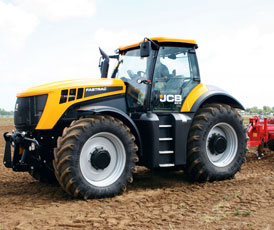Weighing up the variables – tractors at Cereals 2011

It’s all change beneath the bonnet of JCB’s biggest Fastrac as a wholesale switch to AGCO Sisu engines for the high-speed tractors got under way and urea exhaust after-treatment was adopted as the preferred Stage 3B emissions solution.
As part of the package, JCB has also won extended use of AGCO’s CVT transmission – the initial contract with Fendt for the 8250 imposed a 260hp-rated output ceiling. But the two newcomers have equivalent outputs of 256hp and 280hp, with peak figures of 279hp and 306hp versus the 8250’s 280hp.
“The power and torque delivery curves from the new engines are also more favourable, so performance should be better than even the higher output figures suggest,” said product specialist Alastair Gray. “Combined with the proven fuel consumption advantages of Sisu’s SCR-emissions control engines, which should see savings of up to 10%, the changeover is all very positive.”
Electronic engine management was exploited in the new Activ Traction feature, which moderates revs and power output when necessary to keep wheel slip under control, and to add cruise control for more relaxed road driving.
While the big Fastrac’s “Z” chassis remains largely unchanged, JCB engineers have tweaked the suspension, which remains passive coil spring and damper at the front, self-levelling hydro-pneumatic at the rear. They have also made the tractors “GPS ready” so that auto-steer can be easily installed.
Reduced in-cab noise levels also benefit the driver’s lot, while more substantial front mudguards that swivel beyond a certain steering angle should keep the front glass cleaner.
AGCO’s Fendt arm used the Cereals event to unveil three CVT tractor newcomers. With peak Deutz engine outputs of 200hp, 220hp and 240hp, they form a new 700 Vario series that draws on the features and technology of the more powerful models above them while adding their own.
A striking feature of the four-post cab was the way the windscreen curves into the roof to give a better-than-usual upward view to a raised loader bucket or fork. It also featured a track and mounting fixture above the right-hand window that would carry a control box to complement the armrest-mounted Varioterminal, through which a number of different functions could be set up and operated, including the engine/transmission mode and optional VarioGuide auto steering.
Using SCR exhaust emissions control brought up to 7% gains in fuel economy versus predecessor models, said Fendt, with 50kph being achieved at 1,700rpm, adding to the economy potential.
Weighing in at just over 7.9t, but being capable of carrying considerable ballast, should give the latest Fendt 700 Vario series tractors the versatility to tackle a wide range of regular arable farm tasks.
Three CVT-transmission Deutz-Fahr newcomers cater for growers needing less power. At peak outputs of 121hp, 130hp and 142hp, the latest additions to the Agrotron TTV line-up fill out a stepless drive choice from Same Deutz-Fahr that spanned 99hp to 260hp.
Powered by four-cylinder Deutz engines with common rail fuel injection and external gas recirculation (EGR) to regulate emissions, the tractors were available with 40kph (reached at 1,600rpm) and 50kph (1,800rpm) versions of the ZF Eccom transmission and have “active stop” control, which allowed the tractor to be brought to a halt on a slope and held securely without the operator having to service the brakes.
Economy settings for both 540 and 1,000rpm pto speeds are standard to further promote fuel economy, and 1,000rpm pto accompanied the front linkage option.
In the cab, drivers could set and operate numerous functions using Deutz-Fahr’s first integrated terminal. The iMonitor is operated through the tractor’s multi-controller joystick and is ISOBUS compliant. It has integrated Bluetooth hands-free, MP3 player, radio and reversing camera display to keep the operator safe and entertained.
Cereals 2011

